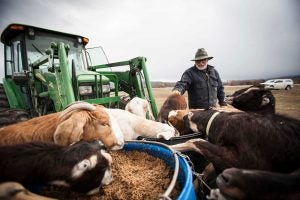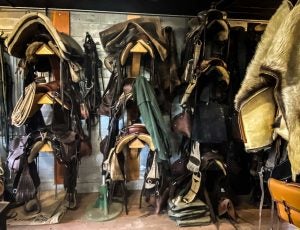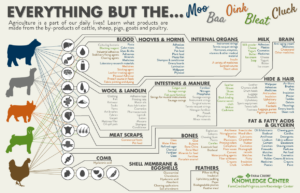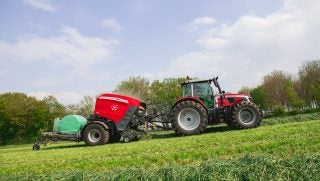Pretty much everything you use on a daily basis has its roots in agriculture. Animal agriculture produces meat, milk, and other food products and crops produce grains and food products. During the process of producing these items, secondary products are often created. These are called byproducts, and many of them are extremely important and are things that you use every day. Byproducts are also a great way to recycle and reduce waste.
Let’s take a look at a few uses for byproducts created by agriculture:
Animal feed products
Over 40 percent of animal feed products are byproducts of other industries! One example is distillers grains. Distillers grains are byproducts of ethanol fuel production and are a high protein feed source for cattle. Other examples include soybean meal, which is what is leftover when soybean oil is extracted for human use, and cottonseed, what is leftover after cotton is used for clothing. There are many more byproducts used for animal feed including: citrus pulp, beet pulp, rice bran, fish meal, almond hulls, brewers grains, carrot tops, bakery meal, blood meal, and so much more.

Fertilizer
One always available byproduct of livestock production is manure. Waste from dairy and beef cattle, swine, sheep, goats, horses, poultry and even fish can be used to fertilize fields used to grow crops. Bedding (also known as litter) from poultry production is also recycled into fertilizer. In fact, over 95 percent of all poultry litter is recycled and used. This fertilizer often cuts down on production costs and increases soil heath and crop yields for future years. Manure can also be captured in methane digesters and turned into fuel and/or renewable energy! We owe a lot to this “waste” industry.
Leather
Skin or hide from animals can be tanned and made into leather. Leather can be used to make durable and long-lasting clothing, shoes, belts, bags, gloves and more. Hide can also be used to make upholstery for furniture, make drums, bind books, make tennis balls, and more. We also wouldn’t have football without the leather used to make footballs (the same goes for baseball).

Skincare & cosmetics
It might be surprising that animal byproducts are used in skincare and cosmetics, but they are often a great use of products that would otherwise go to waste. One example is hyaluronic acid, which is found in chicken’s combs. Glycerin, certain moisturizing acids, squalene, collagen, beeswax, and retinol are some of the other important ingredients used in skincare and cosmetics that can be derived from animal byproducts. Certain colorings can also be animal-based.
Medicine & medical equipment
Animal foods also provide many essential byproducts used to make medicine and medical equipment. A few things that animals provide are hormones, vitamins, insulin, cholesterol and glucosamine. Byproducts also make heart valves and surgical sutures, alongside many other pharmaceuticals, research materials and even culturing bacteria. Interestingly, there is even research into using genetically modified pig organs for human transplant. This is called xenotransplantation and it has the potential to become a large part of medicine in the future.
Household materials
Agricultural byproducts are the source of many common household materials that you likely use every day. This includes adhesives, plastics, wallpaper, plywood, instrument strings, glass, buttons, candles, paint, antifreeze, cement, crayons, fabric softeners, rubber, matches, insulation, deodorant, perfume, paper and more. Many of these items are essential to everyday life, but you’d never guess that they are made from byproducts of most food items.

Food ingredients
As we already know, food comes from agriculture, but many common ingredients and food items are derived from byproducts. Molasses is a delicious sweetener used in some recipes. Molasses is also a byproduct! It’s created during the process of refining sugar from sugar beets or sugar cane. Gelatin and certain flavorings are made from animal byproducts. Even natural sausage casings are made from byproducts, more specifically, intestines! Chewing gum, cake mixes and even pasta can also be made using animal byproducts.
As you can see, agricultural byproducts are a great way to reduce waste and recycle products that would otherwise go to waste. There are many uses for byproducts, many more than are mentioned here. From feeding animals to increasing crop yields to being a part of your everyday life, byproducts are necessary.
Michelle Miller, the “Farm Babe,” is an internationally recognized keynote speaker, writer, and social media influencer and travels full time to advocate for agriculture. She comes from an Iowa-based row crop and livestock farming background and now resides on a timber farm in North Central Florida.



